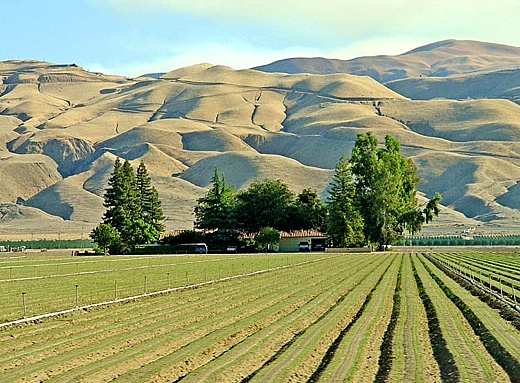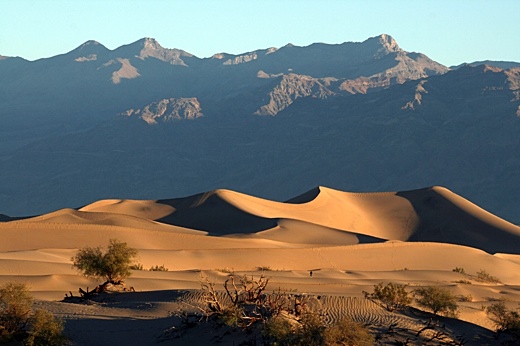SUBHEAD: Grocery prices keeping getting higher: How high will they go? Nobody knows for sure, not even the MANB, the state agency charged with monitoring produce prices.
By Alan D. Mcnaire on 30 December 2009 in Big Island News -
(http://www.bigislandweekly.com/articles/2009/12/30/read/news/news02.txt)

Image above: The Central Valley of California in better days. From http://www.ubcbotanicalgarden.org/potd/2006/11/death_valley_national_park.php
Hawaii's food prices have soared over the past few years. Fresh loaves of unsliced bread that used to cost a dollar at KTA's bakery are now $2.79. The cost of everything, from almonds to strawberries, have risen, often drastically. And they're likely to go higher in the coming months, thanks to factors including a major drought in California's central valley, reduced rainfall in (Big Island's) Waimea "vegetable belt" and increased fuel and shipping prices. How high? There's no way to predict, because the state's agency that monitors produce prices and imports has been shut down.
The Hawaii State Department of Agriculture's Market Analysis and News Branch (MANB) was abolished earlier this month as a cost-cutting measure. It was a tiny agency -- eliminating it saved the state only three full-time positions and one half-time job -- but it served an important function. Since 1946, the MANB had been collecting wholesale data on fresh fruits and vegetables and disseminating that information to wholesalers, farmers and decision-makers.
One of its duties was to track fruits and vegetables coming into the state and shipments from the neighbor islands into O'ahu. The abolition of the MANB comes at a time when the Legislature has been struggling to increase the state's food independence. Earlier this year, it passed HB 1271, which was designed to "Ensure Hawaii is energy and food self-sufficient and sustainable to the maximum extent feasible," only to have the bill vetoed by Gov. Linda Lingle. Now the state may be unable even to measure whether Hawai'i is making progress toward food sustainability, or is becoming even more dependent on crops raised elsewhere.
One Hawaii Department of Agriculture (DOA) official, who preferred to remain anonymous, noted that while the cutting of DOA inspectors has gotten press attention, an inspector could be trained in six months. An agricultural statistician would need much more time to be brought up to speed. And trained people weren't all that was lost. "All the relationships that have been built since 1946 -- that's gone," he lamented.

Image above: Sand dunes in California's Death Valley. From http://en.wikipedia.org/wiki/File:Sand_dunes_in_death_valley.jpg
By Alan D. Mcnaire on 30 December 2009 in Big Island News -
(http://www.bigislandweekly.com/articles/2009/12/30/read/news/news02.txt)

Image above: The Central Valley of California in better days. From http://www.ubcbotanicalgarden.org/potd/2006/11/death_valley_national_park.php
Hawaii's food prices have soared over the past few years. Fresh loaves of unsliced bread that used to cost a dollar at KTA's bakery are now $2.79. The cost of everything, from almonds to strawberries, have risen, often drastically. And they're likely to go higher in the coming months, thanks to factors including a major drought in California's central valley, reduced rainfall in (Big Island's) Waimea "vegetable belt" and increased fuel and shipping prices. How high? There's no way to predict, because the state's agency that monitors produce prices and imports has been shut down.
The Hawaii State Department of Agriculture's Market Analysis and News Branch (MANB) was abolished earlier this month as a cost-cutting measure. It was a tiny agency -- eliminating it saved the state only three full-time positions and one half-time job -- but it served an important function. Since 1946, the MANB had been collecting wholesale data on fresh fruits and vegetables and disseminating that information to wholesalers, farmers and decision-makers.
One of its duties was to track fruits and vegetables coming into the state and shipments from the neighbor islands into O'ahu. The abolition of the MANB comes at a time when the Legislature has been struggling to increase the state's food independence. Earlier this year, it passed HB 1271, which was designed to "Ensure Hawaii is energy and food self-sufficient and sustainable to the maximum extent feasible," only to have the bill vetoed by Gov. Linda Lingle. Now the state may be unable even to measure whether Hawai'i is making progress toward food sustainability, or is becoming even more dependent on crops raised elsewhere.
One Hawaii Department of Agriculture (DOA) official, who preferred to remain anonymous, noted that while the cutting of DOA inspectors has gotten press attention, an inspector could be trained in six months. An agricultural statistician would need much more time to be brought up to speed. And trained people weren't all that was lost. "All the relationships that have been built since 1946 -- that's gone," he lamented.

Image above: Sand dunes in California's Death Valley. From http://en.wikipedia.org/wiki/File:Sand_dunes_in_death_valley.jpg
No comments :
Post a Comment